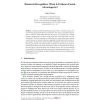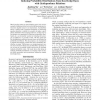345 search results - page 2 / 69 » Fusing Approximate Knowledge from Distributed Sources |
ISVC
2009
Springer
13 years 12 months ago
2009
Springer
Abstract. Having assessed the performance gains due to evidence fusion, previous works reported contradictory conclusions. For some, a consistent improvement is achieved, while oth...
IJCAI
2003
13 years 6 months ago
2003
With the growing use of distributed information networks, there is an increasing need for algorithmic and system solutions for data-driven knowledge acquisition using distributed,...
DATAMINE
2006
13 years 5 months ago
2006
Different from traditional association-rule mining, a new paradigm called Ratio Rule (RR) was proposed recently. Ratio rules are aimed at capturing the quantitative association kno...
AAAI
2010
13 years 5 months ago
2010
When merging belief sets from different agents, the result is normally a consistent belief set in which the inconsistency between the original sources is not represented. As proba...
ICDM
2009
IEEE
13 years 12 months ago
2009
IEEE
—In graph-based learning models, entities are often represented as vertices in an undirected graph with weighted edges describing the relationships between entities. In many real...


